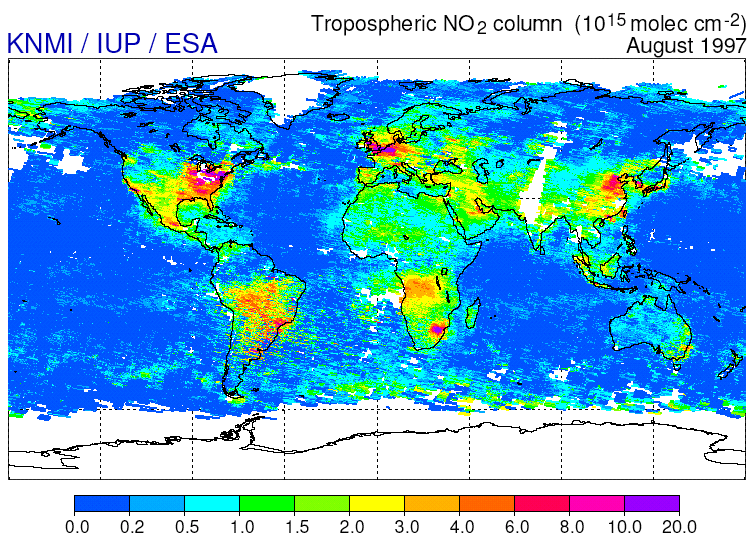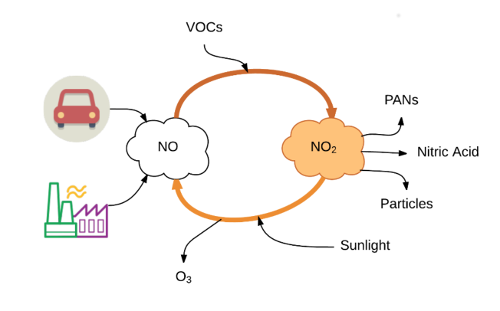
Univ. of Arizona (credits)
A common question asked is why are nitrogen dioxide (NO2), sulphur dioxide (SO2) and carbon monoxide (CO) concentrations always so low and is measuring them useful?
To highlight the importance of monitoring these substances this article is going to explain where these pollutants come from and how to they affect our health and the environment.
To keep things short this article will just focus on NO2.
--
What is Nitrogen Dioxide (NO2)?
NO2 is a reddish brown gas that is emitted from all combustion engines. There are two main nitrogen based compounds that are emitted from combustion engines: NO2 and nitric oxide (NO). Collectively these two pollutants are referred to as NOx or oxides of nitrogen.

To summarize:
- NO2: Nitrogen Dioxyde
- NO: Nitric Dioxyde
- NOx: Oxides of Nitrogen = {NO2+NO}
NO2 life-cycle
At the point of emission (i.e. the exhaust pipe), the proportion of NOx is around 90% NO and 10% NO2 (1).
After a few hours in the atmosphere and in the presence of volatile organic compounds (VOCs) the NO is converted to NO2. This reaction can occur over a couple of seconds to a few hours (2).
NO2 reacts further with other substances in the air to form nitric acid, particulate matter and substances called PANs (peroxyacyl nitrates).
Also with sunlight NO2 can convert back to NO and produce ozone (O3) as a side pollutant. Because of the potential of NO2 to produce these "secondary" pollutants it is important to monitor and regulate NO2.
How does NO2 affect me?
Short and long term exposure to NO2 has been linked with an increased risk of respiratory problems. People with asthma, young children and older adults have an increased sensitivity to its effects (1).
The secondary pollutants caused by the presence of NO2 in the atmosphere also have their own adverse effects. PANs are an irritant, nitric acid causes acid rain and particulate matter and O3 cause respiratory problems.
Who and what is emitting NOx?
As previously mentioned, NOx emissions comes from combustion engines. But what is happening in these engines is the high temperature reaction of hydrocarbons in the fossil fuel with air (which is 80% nitrogen). There are also natural sources of NOx emissions such as wildfires, lightning strikes but the vast majority of NO2 in the atmosphere is caused by human activity.

There are many different industries which emit NOx. The figure (2) shows sources of NOx emissions in the USA measured in 2014. The "mobile sources", i.e. road vehicles, boats, airplanes, farm vehicles etc, are easily the greatest contributor. In the USA and Europe, road vehicles are the main type of ‘mobile source’ of NOx (1) (3).
In areas where road vehicles are the main source of NOx there is often higher NO2 concentrations during peak traffic times such as around 5pm weekdays shown in the NO2 AQI below. Some additonal interresting notes:
- The ozone (O3) concentration increases during the day while the NO2 concentration decreases. That's because NO2 transforms to NOx in the presence of sunlight.
- After 6 PM, the NO2 concentration builds up as there is no sunlight to convert NO2 back to NO.

Figure 3 Example of AQI in London
In China, however a study conducted in 2013 found that industrial sources are the biggest (34% of the total) emitters of NOx (4). This is why there is no strong link with NO2 concentrations and rush hour traffic.
Why are NO2 concentration so low?
The NO2 AQI is usually in the ‘Good’ range and shown in green. But because NO2 is converted to other pollutants which have their own negative effects the NO2 in the atmosphere still negatively affects our health and environment. If you would like a more detailed explanation into NOx in our atmosphere have a look through these documents below.
References and Further Reading
2. Cheremisinoff, Paul N and Young, Richard Alan. Air Pollution Control and Design Handbook. s.l. : M Dekker, 1977. pp. 672-673. Vol. 2.
3. Urban Air Quality in Europe. Boulter, P G, Borken-Kleefeld, J and Ntziachristos, L. [ed.] M Vianna. Berlin Heidelberg : Springer-Verlag, 2013, Handbook of Environmental Chemistry, Vol. 26, pp. 31-54.
4. NOx emissions in China: historical trends and future perspectives. Zhao, B, et al. 13, 2013, Atmospheric Chemistry and Physics, pp. 9869-9897.
